Sustainable Marketing Assignment Sample
Here’s the best sample of Sustainable Marketing Assignment, written by the expert.
Executive summary
Sustainable marketing has been concerned with promoting and developing products that are environment friendly. This study provides information on the elements of sustainable marketing along with its applications in recent years. The first part of this paper consists of theories and models of sustainable marketing and its implementation methods. Brand equity model has been described as well as its importance in sustainable marketing. The second part contains description of sustainability marketing practices of IKEA, The Body Shop and Patagonia. The brand equity model has been implemented to these organizations. Suitable recommendations are provided for organizations regarding sustainable marketing along with a conclusion of the report.
Introduction
Sustainable marketing is a process of management that is responsible for forecasting, identifying and satisfying the needs of customers in a sustainable way. The concepts of marketing have been developed and evolving since the early 1970s and the elements of marketing have been signified in the circumstances of the exchange paradigm. Marketing ideas are implemented in a variety of field that is concerned with services, products, people, and places. The aim of this research is to evaluate theoretical aspects of sustainable marketing as well as its implementation by organizations. The theoretical aspects are evaluated in the first part of the report followed by its implementation in three organizations. Suitable recommendations are provided for sustainable marketing practices to organizations along with a conclusion.
Theory, description and model of sustainable marketing
Sustainable marketing
Marketing concepts has five fundamental elements of the business growth of an organization. Design, development and manufacturing are the primary stage in the cycle of marketing. Organizations then focus on selling and promoting their products and services while considering societal factors (Chernovaet al. 2017, p.823). Long-term research on marketing and customer relationship has shown that organizations have put their focus on creating customer satisfaction for generating long term profit in business. Customer demand or demand for product or services is considered as a vital aspect of marketing. In the concept of the product, it is believed that customers prefer to purchase products that focus on innovation, performance and quality (Aguilar et al. 2016, p.145). Aim is to make improvement on an existing product to improve its quality.
Process of sustainable marketing
Sustainable marketing provides organizations with a competitive advantage in the growing market. The establishment of customer loyalty is another vital aspect of this marketing approach. This marketing method is not limited to taking actions to appear environment-friendly to the consumers. Advertising social consciousness and concern is not the primary aspect of sustainable marketing practices.
Sustainable design:
The products or services that are offered and marketed are developed in a way that all of its stages use environment-friendly operations. As an example, Fuji Xerox’s Green wrap is a product that is developed by making use of environment-friendly materials.
Sustainable positioning:
Each action and activity of the organization makes the promotion of its sustainability performance. These organizations can not engage in activities that are unsustainable as this can have a negative effect on the company’s credibility.
Sustainable pricing:
Companies highlight that their services or products can help them in saving money and important resources for the future.
Sustainable logistics:
Organizations like Amazon, Unilever; Microsoft uses recyclable packaging boxes which reflect their focus on sustainability.
Sustainable disposal:
Unsustainable disposal can harm human health and the environment and organizations focus on following green disposal methods.
Principle and societal classification of sustainable marketing
Principle of sustainable marketing lies under the decisions by an organization in order to meet customers’ choice for long term interest with environmental consciousness. As per the view of Ahamer (2018), concept of sustainable marketing is totally based on environmental and social responsibility for delivering overall economic growth of social issues.
Societal classification of sustainable marketing is generally focused on supply chain issues rather to target potential customers. As per the opinion of Reddy and Reddy (2017), innovation is a key part of societal sustainable marketing.
Sustainable marketing model
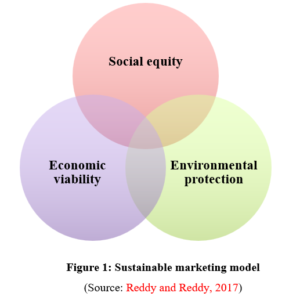
Sustainable marketing is based on three fundamental aspects which are social equity, environmental protection and economic viability. Patagonia has followed this brand development model for economicviability and environmental protection of its brands in a proper way. This brand monitoring and brand development model has helped this organization to understand the financial and societal aspect in a greater manner (Reddy and Reddy, 2017).
Freemium Model
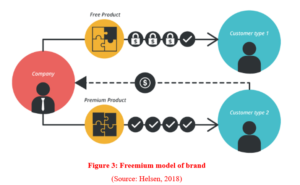
A freemium model is based of different software tools for free service of any brand in an innovative way to the customers with upgraded basic packages. As commented by Helsen (2018), this model offers basic premium service to the customers for a sustainable reputation of business brand all through the world. IKEA Retailer Company has followed this kind of business brand model for the purpose of product line decisions and supply chain control. Moreover, this model becomes able to maintain the tag of ‘low cost products’ of this company for upholding business process with global contribution of success.
Conceptual Framework
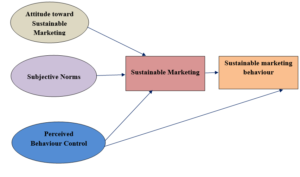
The body shop mainly focuses attitude towards sustainable marketing so it outcomes for sustainable marketing behavior and thus perceived behavior control is achieved. This strategy helps the company to achieve more customers and organizations development. As the selected company main target customer is young generations so company need to maintain the quality of the product orelse target customer would shift to other brand. Thus we can understand that this model plays a key role for the organization development and enhancement. The skincare products of the company are healthy and natural and effectiveness of it provides satisfaction to the customers. The activities of the company consider preventing the use of harmful artificial materials and also aim to prevent environmental degradation. Feelings of the consumers are positive and quality and credibility of the products helps to build brand relationship.
Strategies for Sustainable marketing
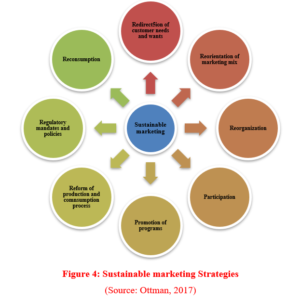
Sustainable marketing strategies are followed strictly by the organizations named Patagonia, IKEA and The Body Shop for maintaining a suitable bridge between government policies and corporate strategy. As commented by Ottman (2017), all the three companies mentioned above has used this strategy to promote program about their brand in global sector. In addition, all the demands and complaints has been followed by these organizationsfor a proper reorientation of marketing mix. It is only possible for any organization to provide sufficient marketing policy through a developed marketing mix. Participation of each and every members are considered as key factor in case of sustainable marketing strategiesto reorganize any kind of uncertainties properly. On the other hand, Patagonia, IKEA and The Body Shop have reform the production process in a suitable aspect to consume any type of market related factor smartly. Therefore, solid business logic and good business can be possible through this decision based strategy for providing positive impact to business.
Organization demonstrating applications of sustainable marketing
Patagonia
Patagonia is an American brand of outdoor apparel and clothing that has implemented sustainable marketing strategies effectively. The company has started trading in the year 1973 as a family business. Its primary focus is to steer the clothing industry by making its efforts towards more sustainable direction (Yang, 2016, p.278). The company is devoted to its sustainability practices and a marketing campaign from the company had encouraged people to refrain from buying their product. They also suggested people not to by-products that they actually do not need.
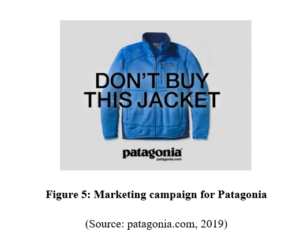
This advertisement was created and promoted by the company to inform customers on the importance of sustainability. The company also donated 100% of their sales on Black Friday to organizations that act on development of the planet.
As per the opinion of Sun et al. (2018, p.178), the company has taken steps to minimize its carbon footprint as the company offers various incentives to its employees. It started offering incentives to employees those use public transportation or carpool to come to work. However, the company has maintained transparency in acknowledging that all of its products are not environment-friendly. There are some delivery and other business activities that require fossil fuels.
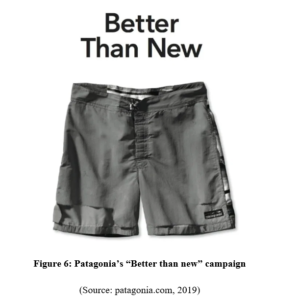
The company ran campaign to make people aware of problems regarding overconsumption and attempted to limit it. It offered clothes and gear that can last for a long time and customers will not require purchasing frequently (Ottman, 2017, p.269). Its “Better than new’’ campaign focuses on the recycling of old and used clothes. The company provides assistance to environmental activist and independent groups that take strategic steps to protect biodiversity, habitat and wilderness.
Link to Brand equity model:
The company has established its identity among the customers by understanding their perception. The decision making process used by customer while purchasing its products are analyzed to assess the value of the brand. It has used the information to develop clear perception among the customers and increase their awareness. Patagonia’s products are identified for its durability and reliability and its focus towards sustainability.
The brand meaning has been developed by ensuring that the quality of the products is high and it can provide satisfaction to the customers. The products of Patagonia are durable and last long while making use of sustainable resources. The judgment and feelings of customers regarding the products are taken into consideration. It has gained higher feelings than judgment by focusing on recycle of old clothes and products. The environment friendlypractices create a positive perception about the concern of the brand regarding the society.
IKEA
IKEA is a Swedish multinational company that design and manufactures furniture and other ready to use home and kitchen appliances. It also develops useful domestic goods and occasional home services for the customers (Katrandjiev, 2016, p.75). The company has established itself as a major player in its market segment and offers quality and affordable range of products to the customers. The company has focuses on sustainability from the beginning of its operation.
The company has established a good relationship with sustainable foresters and sourced wood from them. More than 50 per cent of wood and 100 per cent cotton are sourced keeping sustainability standards on the mind. It has led to a decrease in the use of water and energy as well as harmful pesticides and fertilizers. The company has shown its commitment to sustainability at its stores and it helped the company to satisfy customers.
Link to Brand equity model:
IKEA hasbuilt its identity as a brand that is focusing on providing affordable products and ensuring sustainability in its operations. The company designs and develops products that maintain a high quality and uses sustainable materials for it. The entire business operations of the company are transparent to the customers. Activities from the supply chain to delivery of the product the company have prioritized sustainability. Its use of sustainable materials and focus on reducing harm to the environment has created emotional attachment to the customers. The engagement activities along with establishment of brand loyalty help the company to improve its business performance.
The Body Shop
The Body Shop was established in the year 1976 by Anita Roddick and the company aimed at something revolutionary. The company has focused on sustainable marketing practices to protect the environment and ensured the success of its business. The company is against animal testing and its products are prevented from doing so. It has focused to reduce habitat loss that occurs from intensive harvesting and farming expansion. It has preferred environmentally sustainable methods to complete the process of its supply chain.
The Body Shop has used innovative packaging methods that are sustainable and achieved positive response from the customers. It has designed its products and packaging to use fewer resources and put its focus on recyclability.
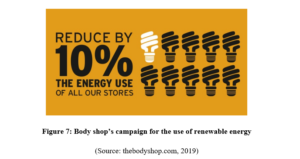
The above figure shows that the use of renewable energy sources has helped the company to reduce its energy consumption up to 10 per cent.
Link to Brand equity model:
The company has made it’s identify as a brand that focuses on developing skincare products made from organic resources. The quality of its products has been satisfactory for the customers and its vision to focus on protecting the environment has helped the company build a positive image (Chhabra, D., 2019, p.367). The skincare products of the company are healthy and natural and effectiveness of it provides satisfaction to the customers. The activities of the company consider preventing the use of harmful artificial materials and also aim to prevent environmental degradation. Feelings of the consumers are positive and quality and credibility of the products helps to build brand relationship.
Recommendations
Sustainable marketing is an ideology that needs to be reflected in each and every activity of an organization. It cannot be only a part of its marketing activity in the marketplace to attract customers on a short term basis. The development of a sustainable marketing campaign needs to be started from the primary stages. The companies need to show that their actions are true to their words. Each activity of a company from sourcing to manufacturing to delivery should be done making use of sustainable material and resources.
Companies can use alternative materials for their products that can maintain sustainability standards. It can be recommended that organizations must avoid practices that convey a negative message to the customers. The activities that do not comply with sustainability standards need to be acknowledged to the consumers. It can be beneficial for organizations to maintain transparency in its operations.
Standardization is needed from regulatory authorities regarding the maintenance of sustainability standards. Government and non-profit organizations need to provide certifications to authenticate use of sustainability practices in business operations. The products and services must be equal in terms of quality to become competitive in the market to be successful. The prices of the products can be higher but the consumers must be aware of its specialties. Companies need to make use of social and print media to inform consumers about sustainability. Development of relatable stories and articles are needed to engage customers and attract them to participate in sustainability. Investors need patients while focusing on sustainable products as can take time to become profitable. The quality and usability of products must be the priority while conducting sustainable marketing campaign. It needs to be able to provide satisfaction to the customers.
The use of Brand equity model can be helpful for the companies to establish and maintain a positive image of the brand.Organizations that are aiming to start business operations needs to use the model to establish identify and meaning of its brand. Brand relationship can be established by focusing on aspect beyond mere consumption of the products. Active engagement and dedication towards the community must be a priority to implement sustainable marketing.
Conclusion
It can be concluded that sustainable marketing has emerged as a priority among organizations in order to achieve long term success. The environmental concern along with climate change has led to brands focusing on the use of sustainable materials and resources. Sustainable marketing requires planning and redesign of products and business operations. Organizations need to develop sustainable marketing strategies to achieve competitive advantage over organizations that do not use it. IKEA has used innovative approaches to promote sustainability and it has helped the company in its business. The use of natural resources and green energy in its stores has received positive feedback from the customers. Patagonia has focused on recycling and reduces overconsumption and developed its marketing campaign accordingly. These organizations show that sustainable marketing needs proper attention in each activity of the company.
References
Aguilar, M., Andereck PhD, K., Chhabra, D. and Schlacter, J., 2016. Proposing a Sustainable Destination Image Marketing Framework: An Analysis of Destination Marketing Organizations in the United States.
Ahamer, G., 2018. The turbo principle in sustainable and developmental learning design. In Marketing Initiatives for Sustainable Educational Development (pp. 1-29). IGI Global.
Athwal, N., Wells, V.K., Carrigan, M. and Henninger, C.E., 2019. Sustainable Luxury Marketing: A synthesis and research agenda. International Journal of Management Reviews.
Calu, A., Negrei, C., Calu, D.A.S. and Viorel, A., 2016. Reporting of Non-Financial Performance Indicators‒A Useful Tool for a Sustainable Marketing Strategy. Calu, A., Negrei, C., Calu, DA and Avram, 2015, pp.977-993.
Chernova, V.Y., Zobov, A.M., Starostin, V.S. and Butkovskaya, G.V., 2017. Sustainable marketing communication strategies of Russian companies under the import substitution policy.
Chhabra, D., 2019. Smart sustainable marketing of the world heritage Sites: Teaching new tricks to revive old brands. In Sustainable tourism: Breakthroughs in research and practice (pp. 207-227). IGI Global.
Daud, S. and Asha’ari, M.J., 2018. Sustainable Marketing and Corporate Sustainability Performance: Moderating Role of Organization Size. Global Business and Management Research, 10(3), p.919.
Georgie, N.A., Varghese, M.A. and Sali, M.H., 2019. Green Marketing as a Pathway to Sustainability. Journal of the Gujarat Research Society, 21(8), pp.310-316.
Goh, W.H., Goh, Y.N., Ariffin, S.K. and Salamzadeh, Y., 2019. How green marketing mix strategies affects the firm’s performance: a Malaysian perspective. International Journal of Sustainable Strategic Management, 7(1-2), pp.113-130.
Helsen, K., 2018. Sustainable Marketing Strategies: Overview.
Helsen, K., 2018. Sustainable Marketing Strategies: Overview.
Katrandjiev, H., 2016. Ecological marketing, green marketing, sustainable marketing: synonyms оrаn evolution оf ideas. Economic Alternatives, 1(7), pp.71-82.
Kumar, B.P. and Venkatasubbaiah, M., 2017. Green marketing and sustainable development. In National Conference on Marketing and Sustainable Development October (Vol. 13, No. 14, pp. 36-42).
Lacoste, S., 2016. Sustainable value co-creation in business networks. Industrial Marketing Management, 52, pp.151-162.
O’Rourke, D. and Strand, R., 2017. Patagonia: Driving sustainable innovation by embracing tensions. California Management Review, 60(1), pp.102-125.
Ottman, J., 2017. The new rules of green marketing: Strategies, tools, and inspiration for sustainable branding. Routledge.
Ottman, J., 2017. The new rules of green marketing: Strategies, tools, and inspiration for sustainable branding. Routledge.
Reddy, D.K. and Reddy, M.S., 2017. A study on Impact of Green Marketing on Sustainable Development (With Reference to Khammam District). In National Conference on Marketing and Sustainable Development October (Vol. 13, p. 14).
Ryals, L., 2017. Issues in sustainable marketing. In Cranfield on Corporate Sustainability (pp. 119-132). Routledge.
Sun, Y., Garrett, T.C., Phau, I. and Zheng, B., 2018. Case-based models of customer-perceived sustainable marketing and its effect on perceived customer equity. Journal of Business Research.
Thulin, S. and Rashid, N., 2017. Chinese students’ knowledge and attitude towards sustainability: focus on IKEA and their sustainability work.
Trivedi, K., Trivedi, P. and Goswami, V., 2018. Sustainable marketing strategies: Creating business value by meeting consumer expectation. International Journal of Management, Economics and Social Sciences (IJMESS), 7(2), pp.186-205.
XIONG, M.L. and CHEN, Y.F., 2018. Discussion on the Strategy of Sustainable Design of Garments—Taking Patagonia as an Example. DEStech Transactions on Computer Science and Engineering, (CCNT).
Yang, X., 2016. Get consumers walk into the sustainability talk: an analysis of consumers’ sustainability perception via business’s sustainable practice, focusing on a case study from IKEA. Master Thesis Series in Environmental Studies and Sustainability Science.
________________________________________________________________________________
Know more about UniqueSubmission’s other writing services:

